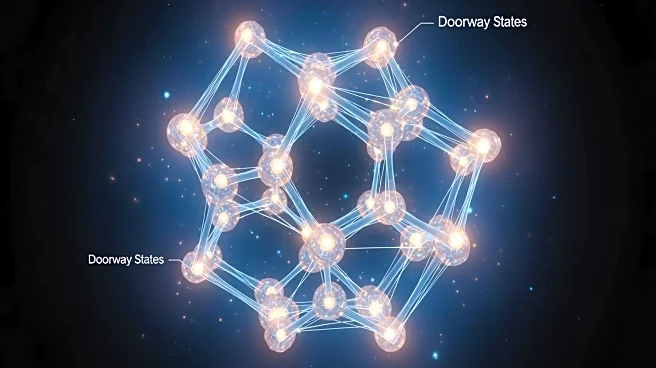What's Happening?
Researchers have developed a novel method to study atomic nuclei by using a single molecule as a tiny particle collider. This approach involves pairing a radium atom with a fluoride atom to form radium monofluoride,
allowing the radium atom's electrons to briefly infiltrate its nucleus. This technique enables precise monitoring of electron energies within the molecule, revealing subtle energy shifts and interactions inside the nucleus. The study, led by MIT physicist Ronald Fernando Garcia Ruiz, aims to measure the magnetic distribution of a nucleus and explore fundamental symmetry violations at the nuclear level. The research could provide insights into why the Universe contains more matter than antimatter, a longstanding mystery in physics.
Why It's Important?
This development is significant as it offers a new way to probe the inner workings of atomic nuclei without the need for large-scale particle colliders. By using molecules as microscopic colliders, scientists can gain insights into fundamental physics questions, such as the matter-antimatter asymmetry in the Universe. The technique could lead to breakthroughs in understanding nuclear properties and symmetry violations, potentially impacting fields like particle physics and cosmology. The ability to study nuclei in this manner could also advance research in nuclear energy and other applications where understanding nuclear interactions is crucial.
What's Next?
The researchers plan to further refine this technique to explore other atomic nuclei and their properties. Future studies may focus on measuring violations of fundamental symmetries in different nuclear systems, potentially leading to new discoveries in physics. The method's success could inspire similar approaches in other areas of atomic and molecular physics, broadening the scope of research into nuclear interactions and their implications for the Universe.
Beyond the Headlines
The study highlights the potential for using molecular systems to explore complex nuclear phenomena, offering a more accessible and cost-effective alternative to traditional particle colliders. This approach could democratize access to nuclear research, allowing more institutions to participate in cutting-edge studies. Additionally, the findings may have implications for developing new technologies based on nuclear properties, such as advanced energy systems or novel materials.











